|
|
|
Sort Order |
|
|
|
Items / Page
|
|
|
|
|
|
|
| Srl | Item |
| 1 |
ID:
109140
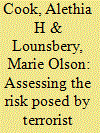

|
|
|
|
|
| Publication |
2011.
|
| Summary/Abstract |
While terrorist organizations have been analyzed for their motivations and tactics, little has been done to develop a systematic understanding of what makes some groups more dangerous than others. Knowing what makes some groups more threatening than others, or what conditions can influence a single group to become more or less of a threat, would help governments to prioritize resources during counterterrorism efforts. Using an approach similar to Ted Robert Gurr's assignment of a risk score to identify impending minority group rebellion, this article develops and tests a set of terrorist organizational characteristics. A two-phased approach is used. First, the authors identify key characteristics that could be anticipated to drive groups to be more active or deadly. The characteristics were identified and measured for terrorist groups for 1990-1994. The authors test group characteristics against subsequent group violence intensity from 1995 to 1999. Findings indicate that some group characteristics, such as religious ideology and group size, are important to understanding a group's relative level of violence. Though the study focused on a relatively short period of time, the findings indicate that a more comprehensive study of the impact that group characteristics have on violence levels would be a worthwhile undertaking.
|
|
|
|
|
|
|
|
|
|
|
|
|
|
|
|
| 2 |
ID:
145530
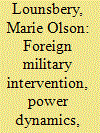

|
|
|
|
|
| Summary/Abstract |
Third-party states use foreign military intervention as a tool to influence the outcome of intrastate conflict. The literature identifies other consequences associated with this intervention but has not yet examined its effect on rebel group cohesion. We might expect rebel groups to coalesce or splinter depending on the direction of the intervention. This paper tests this relationship on all intrastate armed conflicts during the period from 1975 to 2009. It finds that rebels tend to coalesce when a foreign power intervenes on their behalf. External interventions, whether supporting the rebels or the government, however, do not appear to influence rebel group splintering.
|
|
|
|
|
|
|
|
|
|
|
|
|
|
|
|
| 3 |
ID:
152886
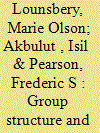

|
|
|
|
|
| Summary/Abstract |
Studies have begun to look at the potentially crucial impacts of group decentralization and inter-group global networking in accounting for the extent and severity of violence in insurgencies and terrorism. Groups may be able to survive more effectively, evade anti-terror or counter-insurgency strategies, and inflict greater damage or more civilian attacks by operating under more or less centralized leadership, or by making use of the resources of other like-minded groups scattered across borders. While some analysts have examined each of these possibilities, few if any have done so simultaneously with both structural and networking indicators or examined the joint effects of these indicators. We propose to do so in this study by combining existing datasets on terrorist structure and networks. Hypotheses and findings in prior studies have indicated that structural decentralization may lead to more civilian attacks if not more destruction since local cells are freer to act on their own, and that group size and centrality in the global terror networks lead to greater lethality and group survival rates. We re-examine such assumptions here with OLS and logit models combining these effects, and find that in addition to group size, network reach (eigenvalue centrality) rather than group interconnections per se (number of allies) appears to have primary impacts on group lethality, targeting, and survival, sometimes in conjunction with decentralized organizational structure.
|
|
|
|
|
|
|
|
|
|
|
|
|
|
|
|
| 4 |
ID:
102510
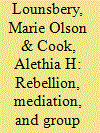

|
|
|
|
|
| Publication |
2011.
|
| Summary/Abstract |
Multilateral and diplomatic resolutions to intrastate conflicts are the preferred method of termination. However, mediated settlements tend toward failure and conflict recurrence. A significant factor in this failure is that government and groups are heterogeneous. While the demands, goals, preferences, and intentions of both sides are sometimes viewed as being held in common, they are potentially as diverse as the groups' members. Understanding the relationship between resolution efforts and group heterogeneity is complicated but crucial to improving mediation success. The current article examines all intrastate conflicts for the period 1945-1999, in order to test two competing propositions found in the literature on group change and the occurrence of mediation. The primary question of interest is whether group change tends to result from or precede mediation attempts. In other words, is group change an impetus to engage in mediation or do mediation processes tend to result in altered group characteristics. The findings support only the proposition that when governments engage rebels in mediation, rebel group changes are significantly more likely to occur than without mediation. The implications of the findings are also discussed.
|
|
|
|
|
|
|
|
|
|
|
|
|
|
|
|
| 5 |
ID:
147530
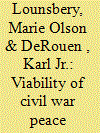

|
|
|
|
|
| Summary/Abstract |
Civil war peace agreements are prone to collapse. While some research suggests that multiple layers of power-sharing provisions lead to more viable agreements, others have suggested that negotiated settlements are not only more likely to return to violence, but that those cases will be more deadly as a result. We suggest here that previous research has failed to address the various ways that peace agreements emerge and that this context is crucial in explaining peace agreement viability. In some situations, rebels are likely to earn those concessions through battlefield success. Governments may feel compelled to address underlying grievances in order to stop the bloodshed and ultimately maintain some political clout in the postwar regime. In other cases, however, governments may feel pressure to engage in discussions and to provide concessions by outside actors, whether in the form of diplomatic intervention, economic, or foreign military intervention. Hypotheses are tested on all civil war peace agreements identified by the UCDP Peace Agreement Data-set for 1975–2011. Findings from logit and hazard models suggest that agreements brought about in the aftermath of military intervention on behalf of rebels are more likely to endure while those earned on the battlefield (i.e., stronger rebels) do not. In addition, mediation enhances peace agreement viability, while interventions on behalf of governments tend to undermine it.
|
|
|
|
|
|
|
|
|
|
|
|
|
|
|
|
|
|
|
|
|